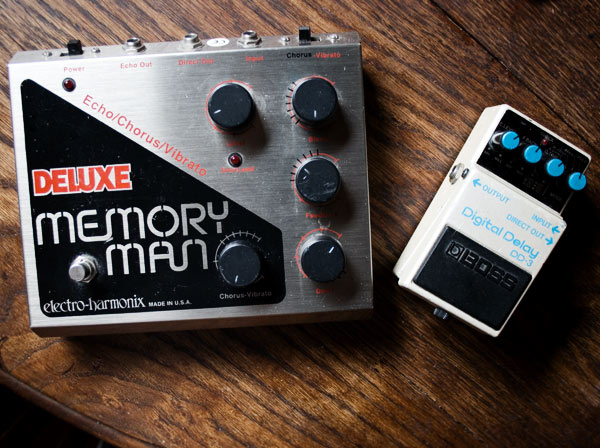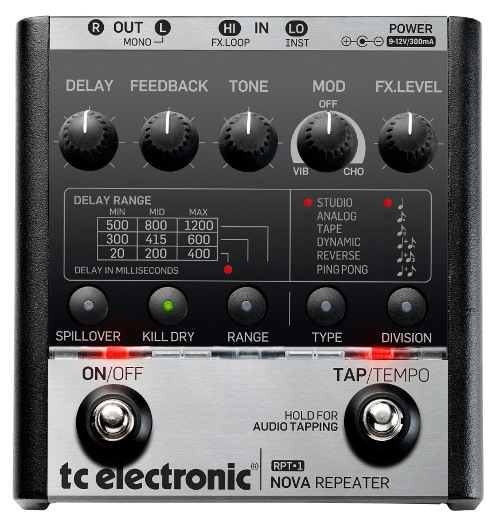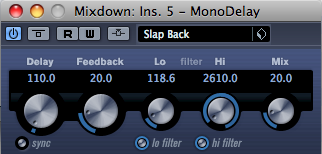In Part 1 of this series of posts dedicated to the use of delay, I have shown how to create rhythmical effects “à la U2” by synchronizing the delay to the tempo of a song. Today, in Part 2, I will first give you a few example settings showing how to fatten your tone using a Boss DD-3 and an Electro Harmonix Deluxe Memory Man. After the videos, I will explain the differences between analog and digital delays as they both have distinct sounds and when it comes to choosing a delay pedal, the analog versus digital debate is still very much alive!
Fattening your tone: the “guitar hero” delay effect
Here is a personal favorite of mine, the type of delay that countless 80s guitarists used pretty much all the time to season their fierce solos. I have reproduced it using a Digital Boss DD-3 as well as an Analog, darker sounding Electro Harmonix Deluxe Memory Man:
Gear used: American Classics Stratocaster with Kinman pickups -> Analogman TS9 -> Proco RAT 2 -> Marshall JMP-1 preamp plugged direct into the recorder
To recreate this type of delay using a software plugin or multi-effect, set a delay time around 350 ms, 3 or 4 repetitions and a mix level of about 25%. Results may vary depending on your exact equipment. As always, experiment to find out what you are most confident with and most importantly what the song you are working on exactly needs.
Fattening your tone: the slapback echo
I have written a complete post about it so I will only give the audio examples here. The slapback echo is the “mother of all delays”. It consists of only one short repetition. As simple at it may seem, it is a very effective tool as shown in this video:
Gear used: 78 Telecaster -> Proco RAT 2 -> Fender Champ
In the video, the slapback delay is generated using Cubase 5’s delay plugin with the following settings:
You can achieve the same type of tone with a Boss DD-3 and the following settings: Mode 200ms, E.LEVEL at 12 o’clock, F.BACK at 9 o’clock and D.TIME at 4 o’clock. You might want to vary the E.LEVEL or D.TIME to taste. It is easy to reproduce this effect with any other model of delay, just set the “delay time” between 70 and 200ms and the “feedback” quite low in order to have just one repeat.
Fattening your tone: Multitap delays
When one delay is not enough, use several of them! Known as “Multitap Delay”, the use of two or more delay units multiply the possibilities. Here I show the Boss DD-3 and the Electro Harmonix Memory Man together. Note that I had to reduce the delay time on the DD-3 compared to the first video, reason being that the previous settings were too close to the Memory Man and did not create enough of a swirl:
Gear used: American Classics Stratocaster with Kinman pickups -> Analogman TS9 -> Proco RAT 2 -> Marshall JMP-1 preamp plugged direct into the recorder
Again experimenting is the key here. I have used two delay settings that were quite similar but you can also use two delays with very different settings like a short one and a long one. At some stage, Joe Satriani was using three delays at once: one with a short delay time, another one with a medium delay time and a third one with a long delay time. It gave his tone almost a reverb like feeling.
The Analog vs Digital Debate
After seeing these demos you might want to go shopping for a delay pedal and must be wondering: “analog or digital?”. We have to go back in time in order to understand why there are several types of delays on the market.

Tape Based Delays
Earliest delays were tape based. They were even created using studio recorders. One tape head would record and another tape head would play the same tape a very short time later creating the first artificial echo in history: the slapback echo. It was limited to one repetition and the delay time was short. Nevertheless it almost shaped an era in terms of sound as early rock’n roll and rockabilly records made a heavy use of it and not only on the guitar but also on vocals and drums.
Some companies were quick to create “echo” units with tapes inside to reproduce this effect. Eventually these tapes units became more capable and could create a whole range of delay effects and not only slapback echos. Among these legendary units, there is of course the echoplex used by Jimmy Page, the Binson Echorec used by David Gilmour on early Pink Floyd records in the 60s or the Roland RE series. A distinct feature of tape based delays is that each repetition is a bit “degraded” due to tape coloration which is a feature that guitarists came to love.
Analog “Bucket Brigade” Delays
In 1969, the Bucket Brigade analog delay line was invented. It allowed effect manufacturers to create delay units that did not required bulky tapes which needed to be replaced and maintained. The delay in a pedal was born. Analog delays did not sound quite like tape based delays but did feature a “degradation” of the repetitions which were darker than the original. Small sized and cheaper, they became guitarists staples. Popular models included the Electro Harmonix Memory Man (still made today) and the BOSS DM-2 and DM-3.
Digital Delays
In the eighties, alongside improbable hairdos and shoulderpads, digital audio technologies became widespread and made their way into recording devices, musical instruments and effects. Digital delays were born using the same type of technologies that samplers used. They would digitally record the incoming signal and replay it a number of times. The thing about digital delays is that the repetitions sound really clean, not degraded when compared to a tape based or analog delay.
This is something that people found cool at first but you know guitarists, some of them did miss the warmth brought by the uncleanliness of old analog delay units. This explains why these are still sold today, together with their digital cousins. The most expensive digital delays had clear indications of the delay time to the millisecond which is something that analog or tape based delays lacked. This was a big advantage and a lot of guitarists jumped on the digital bandwagon for this reason. This is the case for The Edge and David Gilmour who had gotten tired of their unpredictable analog delays
Boss has the claim to releasing the first digital delay in compact pedal form in 1983: the DD-2. It was quite quickly replaced by the DD-3 which is still made today! The DD-3 lacks recent features I mentioned in Part 1, such as Tap Tempo or musical subdivision. Also it has a resolution of “only” 12 bits which makes it not entirely high fidelity but it does not matter that much with a guitar. I really like my DD-3 as I think it sounds good and can create all sorts of delays, perfect to fatten your tone in a digital way. Boss also offers the compact DD-7 or the twin DD-20 which offer Tap Tempo and musical subdivisions.
Analog Emulation or True Analog Tone?
A number of recent digital delay pedals include “recreations” of tape based or analog delays where the audio degradation of the repetitions is simulated. It is a good way to get a tape or analog type of delay tone without having to find an actual tape unit and without sacrificing modern features like Tap Tempo and musical subdivisions. Boss has even released a digital recreation of the popular Roland RE series. The pedal is called RE 20 and seems to have quite some fans. Other models capable of tape and analog delay recreations include the Line 6 DL-4 and Echo Park, the TC Electronic Nova Repeater and Nova Delay, the BOSS DD-20 and DD-7 or the brand new Joe Satriani designed Vox Time Machine. Kudos to the Ibane DE-7 which must be the cheapest of the lot. Now, as always, do these digital recreations sound exactly like the real thing? Maybe not, but it all depends on your preferences and what your ears are telling you. It sure does work for a lot of people including pros.

If you want the real analog thing, know that quite a few high end boutique manufacturers are making analog delay pedals based on Bucket Brigade devices. Check them out: Analog Man AR20DL and ARDX20, Diamond pedals Memory Lane 2, Retro Sonic Analog Delay, etc. Let’s not forget non boutique manufacturers such as MXR with the Carbon Copy delay, Maxon with the Analog Delay Pro or good old Ibanez with the AD-9. And of course, Electro Harmonix is still making the legendary Deluxe Memory Man which has now a lot of little brothers of all sizes. This includes the Deluxe Memory Boy, a digital/analog hybrid which sports an analog circuitry as well as features such as tap tempo and musical subdivisions which are usually non existent in analog pedals.
Analog Delay vs Digital Delay: Sound Examples
Here are two audio examples showing the difference between analog and digital delays.
First, using my analog Electro Harmonix Memory Man, note how each repetition is darker than the previous one, that is what gives analog delays their warmth. For some extra shimmer, the Memory Man features a chorus/vibrato which I have set to zero in this example:
Then my trusty Boss DD-3, note how repetitions are not getting darker as they go, this gives digital delays a certain sharpness:


unfortunate there is not mention of the SMMwH becuz IMO it is a great digital delay.
There is a number of pedals I could not put in the posts without it becoming too long. You are right, this is a great pedal and will be found on the Electro Harmonix website. For those of you who are wondering, SMMwH is “Stereo Memory Man with Hazarai”.
Another great article!!!
The Boss DD-2 was actually in production for 3 years. If you can find one or an early DD-3 they are superior (IMHO) to the more modern DD-3. The DD-2 was the first digital pedal that Boss made and the worlds first stompbox Digital Delay. The cool part is it was based around the rather amazing chip made for the large Roland SDE-3000 rack mounted digital delay – which was the industry standard in its day. By luck, this chip just fits across the width of the compact pedal and for months the design team worked to sqeeze the rest of the components on to the printed circuit board. But, this process could not be automated and all of them actually had to be manually hand-wired. In December 1990 Boss revised the first generation DD-3 by doing away with original “large” with a smaller PCB mounted type which was both cheaper and did not require the more expensive and time-consuming hand-wiring like the DD-2 and first DD-3s.
The early, Gen 1 DD-3 was the same pedal as the DD-2. Because of the price drop on DRAM in 1986 it was possible to produce the pedal much cheaper. Dropping the price didn’t look so good so it was decided to re-release the DD-2 under the name DD-3 instead. The front of the pedal got a face lift with the re-release. But, essentially they are the same pedal until Boss discontinued the usage of the superior “large” chip. These Gen 1 DD-3s can be ID’ed by their serial number DD-3Serial: 690000 – NC09999. Also, you can see the “large” chip when you open it.
One again, lots of great info in your comment! My DD-3 is a “Made in Taiwan” model so I doubt it is a Gen 1…
very good site! congratulations
Thank you!
Any way I can get the delay, phaser and flange settings for eddie’s intro to women in love, much thanks
I understand the differences between Analog VS. Digital Delays. I feel they both have their place. I purchased a MXR Carbon Copy Analog Delay when they first came out because I was curious. I had been using the Boss DD-2 Digital Delay and the Boss DD-3 Digital Delay for years. When Boss released the DD-7 Digital Delay I had to have it. Well for me digital is the way to go. Why? Because I really like the crisp and clear repeats that slowly fade off by volume drop without losing the clarity of the note. The MXR was okay and did indeed deliver as promised a really great analog delay. I just didn’t like how the note degraded as it faded off. To me both are excellent choices which comes down to which type you like best. We live in a “Golden Era” of the stomp box. There is something for everybody including price ranges which is awesome. Which ever you choose or prefer enjoy and have fun. After all, that’s what guitar playing should be all about.